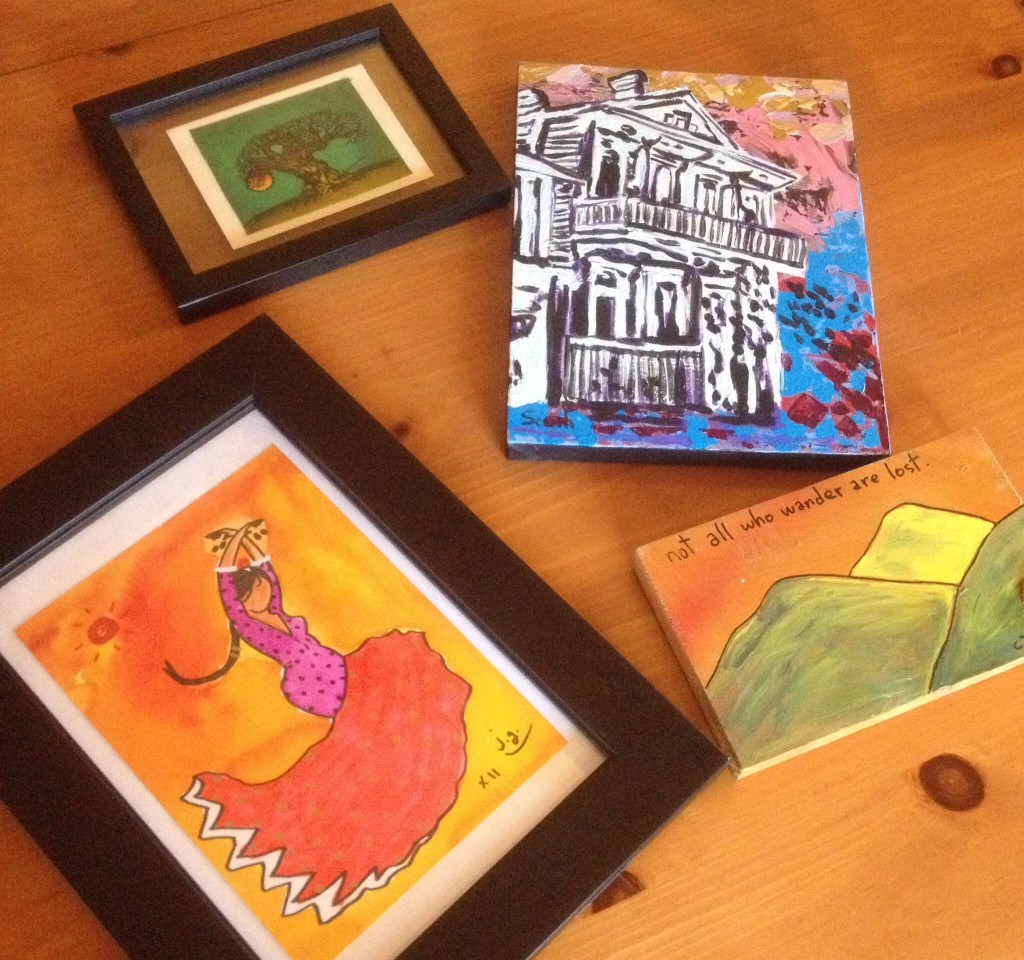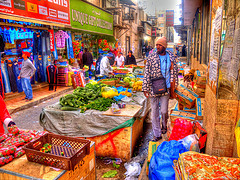
I recently visited the home of Maryland artist, poet, and world traveler Joan Henderson Hodous. Not only does she have a lifetime of incredible memories and seven decades of travel adventures, her home reflects her travels and serves as part of her inspiration. I spoke to her about one of her favorite collections because it really intrigued me. Joan collects small (6 inches to a foot tall) figures of women from every culture she has visited. Looking at just a portion of her collection in her ‘inspiration room’ and I was overcome with so many ideas and questions on the role of women, the importance of female figures, and the representation of the female form across cultures. Frankly, it made me want to rewind three years and choose a completely different masters thesis topic!
But it got me thinking… What do we tend to collect when traveling? Why do we feel the need to bring these remnants home? Does this vary across cultures? When visiting another country, what are we inclined to buy? Are we using our purchasing power responsibly? Are our dollars/ euros/ dirham/ pesos being driven into the local economy or global corporations? Why has travel become almost synonymous with shopping? Are we collecting meaningful items and memories during our travels or just more stuff?
Here are a few tips* to ensure that our consumer habits abroad support the local community and provide a more authentic cultural experience.
- DON’T collect things just for the sake of collecting . This goes hand in hand with the hoarding mentality and so many feeling tied down because of “stuff”. Some common items travelers collect include insignia items like mugs, key chains, magnets, patches, pins, and more. Are these really what best represents a culture? Now, I’m not saying these items should absolutely never be bought; I am suggesting that we ask ourselves just how authentic that item is and if that item or collection of things is a meaningful reminder of your experience in a particular culture.

A small sample of what I DO collect when I travel – pieces of art from other cultures. Photo Credit: Sarah Dilworth
- DO collect postcards! This is one thing sold in most tourist hubs that I do advocate everyone collecting. While it isn’t insta-gramming, nothing beats the old-fashioned excitement and anticipation of receiving a handwritten note, not to mention how great they look matted and framed! And rather than rushing to every tourist hot spot in a city and obsessing over getting the perfect shot of a particular building/ statue/ park, grab a postcard of that professionally produced shot for yourself, then go on to enjoy your actual experience in that park or museum.
- DO collect items that are unique to the culture, and have particular value, meaning, or usefulness to you. If you are a foodie, perhaps a Moroccan tajine or authentic Spanish paella pan may be a sound investment. Handspun, woven, or beaded fabrics, scarves, and tapestries can be of great use and bring a bit of another culture into your own home. Buy a small piece of work from a local artist set up on the street or at a market (this is something that I personally collect). Books by local writers can also be a great remembrance and let’s not forget a bottle of regional wine, spices, or other items that are permissible to bring back to your home country.
Your desire to buy souvenirs may depend on the amount of time you are spending in another country. What often happens is that long term inhabitants don’t necessarily set out to collect items from the culture in which they are living; it happens more organically. When we are in a culture on a shorter time frame, we sometimes feel this pressure to buy that “perfect” souvenir or simply as many THINGS as we can fit in our carry-ons in an effort to remember a given country.
- DO frequent markets and buy local. Buying local doesn’t just refer to locally grown produce, meat, dairy, and other food products, but locally produced goods and artisan products. Supporting locally owned organizations, food stands, cooperatives, cafes, hotels or guesthouses (and avoiding chains) is another way to ensure your travel and purchasing power is used responsibly.
Markets are an integral part of everyday life in many cultures and take place in various forms around the world. But one thing is for certain, the market is a place where you can interact with other locals doing their shopping, local vendors, farmers, artists, and really get a feel for the local community. I mean, doesn’t building rapport and haggling with a vendor in a busy, loud, colorful souq beat standing in line at H&M any day?

- DON’T forget to check the labels (and/or speak with the vendor about the origin of a product). In the wake of the recent garment industry horrors, more businesses’ practices of cheap and illegal labor have come into view. If you do find yourself in one of those corporate chain stores, educate yourself on their policies and how their clothing is made and where it actually comes from. Even if you are buying from a vendor in a market, it is always a good idea to learn about the process of where and how they get the goods they sell. This also is a great way to start up conversation, practice language, and makes the experience of shopping a fun and memorable one!
- DO use shopping abroad as a way to immerse yourself and live like a local. Find out where locals do their shopping. Head off the tourist trail to that outdoor market in a residential district of town. Practice your language skills through chatting with vendors. Observe the interactions going on around you. If you are in a culture where haggling is an expected part of the exchange of goods, try your hand at it in a responsible and respectful way. It can seem intimidating to some, but in the end, is a huge part of the authentic experience.
Being mindful of our purchasing power at home and abroad is key to not only ethical consumerism, but ethical global citizenship as well. It is unrealistic to advocate a halt on buying reminders of our travels. Quite frankly, I love everything I have brought home from another culture. But it is important to remind ourselves, your students, or fellow travelers that being glued to your iphone’s camera app, obsessively searching for something to buy, or visiting the tourist hot spots are not the only takeaways we, as International Educators and travelers, have from our experiences in another culture.
*These tips can (and should) be applied to your consumer habits not only when abroad, but also wherever you consider to be home.
 About the Author: Sarah Dilworth is a travel lover from the mid-Atlantic region of the United States whose passion for experiencing other cultures has taken her to over two dozen countries on three continents so far. She earned a Masters Degree in Intercultural Studies from Dublin City University in 2010. Sarah has worked in the nonprofit sector facilitating cultural exchange, primary and secondary education, and is a member of the Melibee hive. She currently splits her time between Ireland and the US.
About the Author: Sarah Dilworth is a travel lover from the mid-Atlantic region of the United States whose passion for experiencing other cultures has taken her to over two dozen countries on three continents so far. She earned a Masters Degree in Intercultural Studies from Dublin City University in 2010. Sarah has worked in the nonprofit sector facilitating cultural exchange, primary and secondary education, and is a member of the Melibee hive. She currently splits her time between Ireland and the US.


Thank you for the helpful tips. Can we trust that the vendor is selling what they say? In other words is it really authentic? How can consumers really know?
How can a consumer know if what they are buying is authentic?